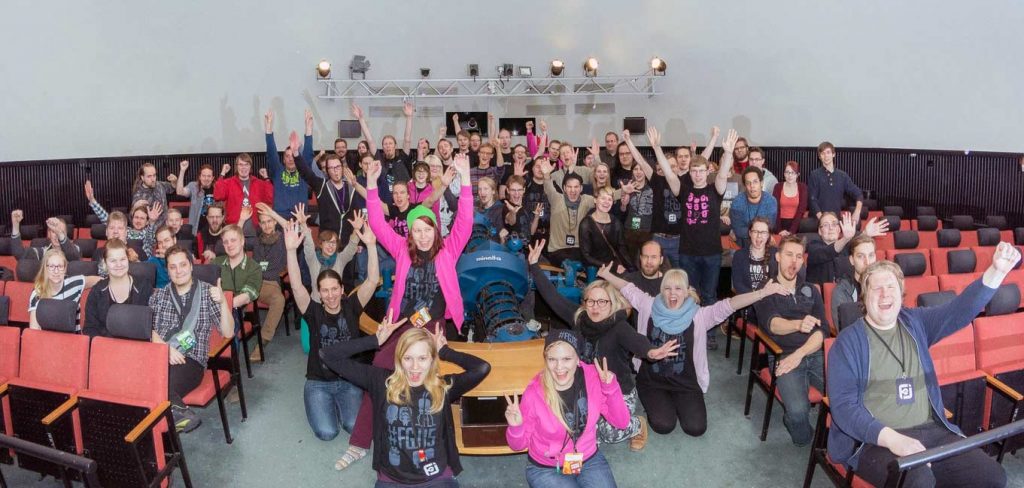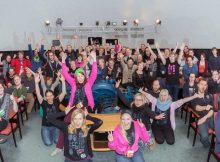Annakaisa Kultima, Kati Alha and Timo Nummenmaa, researchers at the University of Tampere, have coauthored a paper at the Academic Mindtrek 2016 that presents a case study of Finnish Game Jam and of the community built around it. Consisting of post-event surveys collected during 2010–2016 and statistics collected from the event participant registration forms, the study provides an overview of the Finnish Game Jam scene and some suggestions for fostering similar game development ecosystems with national support schemes.
Game jams are events where people gather together to create games in a relatively short time. The games explore various design constraints and they are publicly shared after the event. The projects are usually conducted in small teams of 2 to 7 jammers. Game jams are very similar to – if not synonymous with – game development hackathons. The phenomenon has grown exponentially during the 21st century. Some of the largest and most globally recognized events include the online game jam Ludum Dare (LD), and the Global Game Jam (GGJ), which Finnish Game Jam (FGJ) is a part of.

There are many types of game jams build around many sorts of ideas. Events can differ with varying locations, timeframes, design topics and objectives. Researchers are becoming increasingly interested in examining game jams as compressed development processes which can rapidly go through different steps related to game creation. Game jams generate experimental game concepts that can turn into successful games, and they foster developer communities that can turn into engaging lifestyles.
Finland has been participating in Global Game Jam since 2010 and steadily growing. Comparing 2010 and 2016, the number of jamming sites has gone up from 3 to 22, and the number of jammers went from a bit less than 100 to 927 (over 80 of them organizers). Meanwhile, the gender gap has been moderately eased from 9% female participants to 19% of them. These growth numbers are substantial when considering that there are only around 2500 people working in the Finnish game industry. Finland was also the sovereign state that produced the most games per one million inhabitants, and even ranked 6th on the total number of games produced, despite the country’s small size.
Despite the large geographical distance between the jamming sites, Finnish Game Jam has been able to successfully sustain active collaboration between them. Community management methods include marketing the local events under the FGJ brand, producing nation-wide keynote videos, and hosting a separate, light-hearted awards ceremony. The non-profit organization established in 2013 has also helped in extending the operations outside the annual GGJ event and in cultivating the national jamming scene.
The case study also highlights some perspectives from the answers which were given to the open-ended questions in the feedback form, collected after the game jam events. These surveys were mainly collected for helping improve the future events, and processed internally among the organizers. A total of 497 responses have been collected between 2010–2016.
In addition to the general excitement of creating games and the high quality of the games produced, the positive feedback over the years has concentrated on the general, social atmosphere of the events. Participants consider the jams as an opportunity for having fun with old friends as well as meeting new people. The volunteering organizers are considered very helpful and the social facilitation is highly valued. Attendees also like the no-cost nature of the events and appreciate sponsored facilities, foodstuffs and swag such as T-shirts.
“Everyone was very friendly and helpful. As a Finn, I’m not really used to this.”
– Jammer, Site A, 2016
The negative feedback mainly revolved around the effects of inefficient organizing. When informing about the event was insufficient, arrangements at the site seemed confusing the attendees. Some sites were criticized for poor social facilitation and unclear schedules. Some participants felt the development atmosphere was unnecessarily competitive, and others wished for healthier food options on-site.
“I was told to join a group of 5+ or leave. Please don’t force people into big random groups.”
– Jammer, Site C, 2014
The event design of FGJ does its best in addressing these challenges through social facilitation and active community management throughout the year. Presenting the games during and after the jams, national streams and voluntary team facilitation help jammers old and new feel welcome to the scene. Meanwhile, success stories like Supercell and Rovio draw more people to creating games. The paper ends on a note describing the relationship between the events and Finnish game developers:
“The role of jam organizers as nurturer of local developer communities is important to the overall success of the national industry.“
Article: Building Finnish Game Jam Community through Positive Social Facilitation
Authors: Annakaisa Kultima, Kati Alha & Timo Nummenmaa, Faculty of Communication Sciences, University of Tampere, Tampere, Finland, EU
Publisher: ACM (Association for Computing Machinery)
Publication: Proceedings of the 20th International Academic Mindtrek Conference
Published: October 2016
Language: English
Online: http://dl.acm.org/citation.cfm?doid=2994310.2994363 (subscription required)
Project Website: http://www.finnishgamejam.com/
